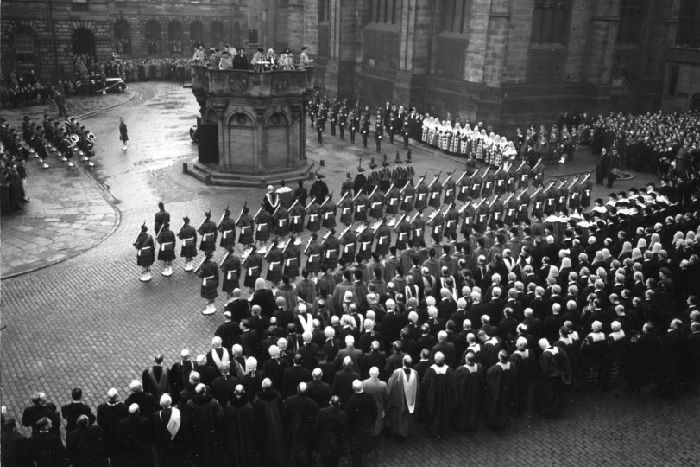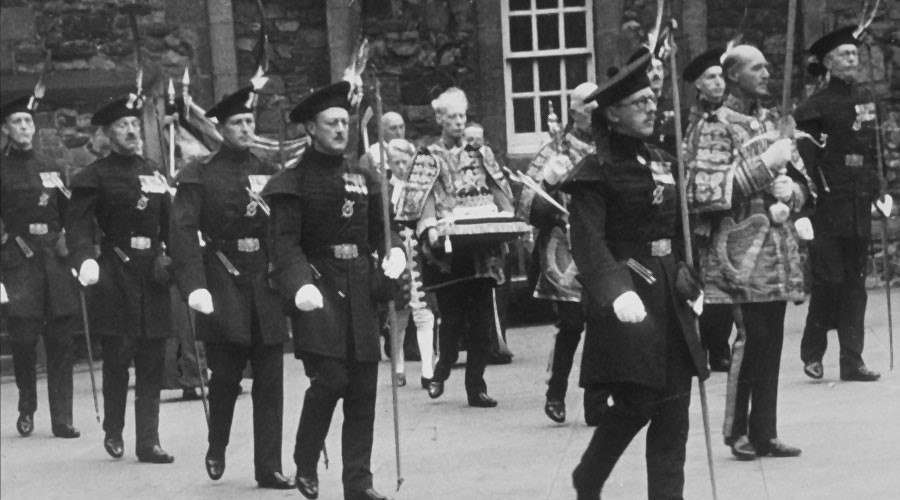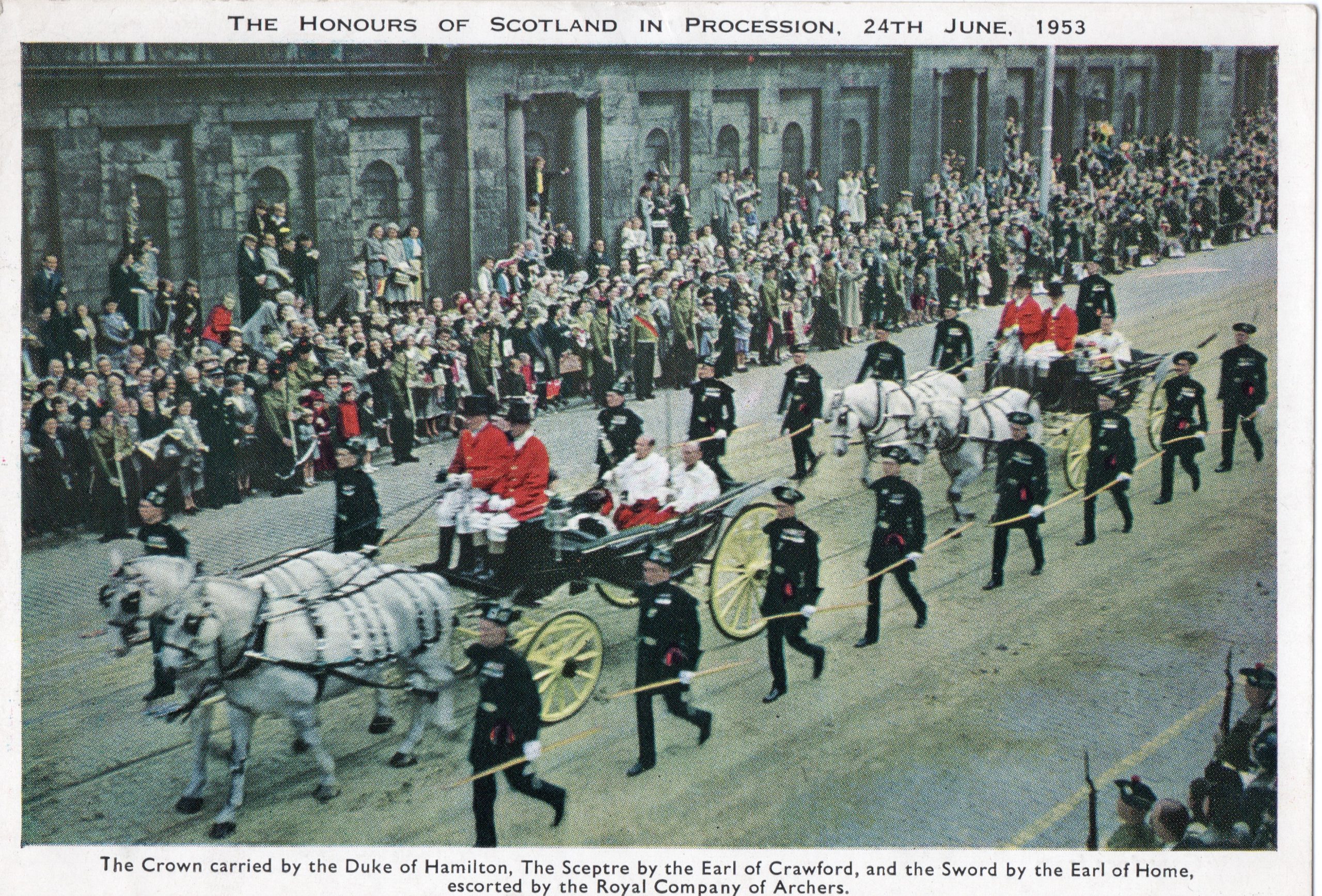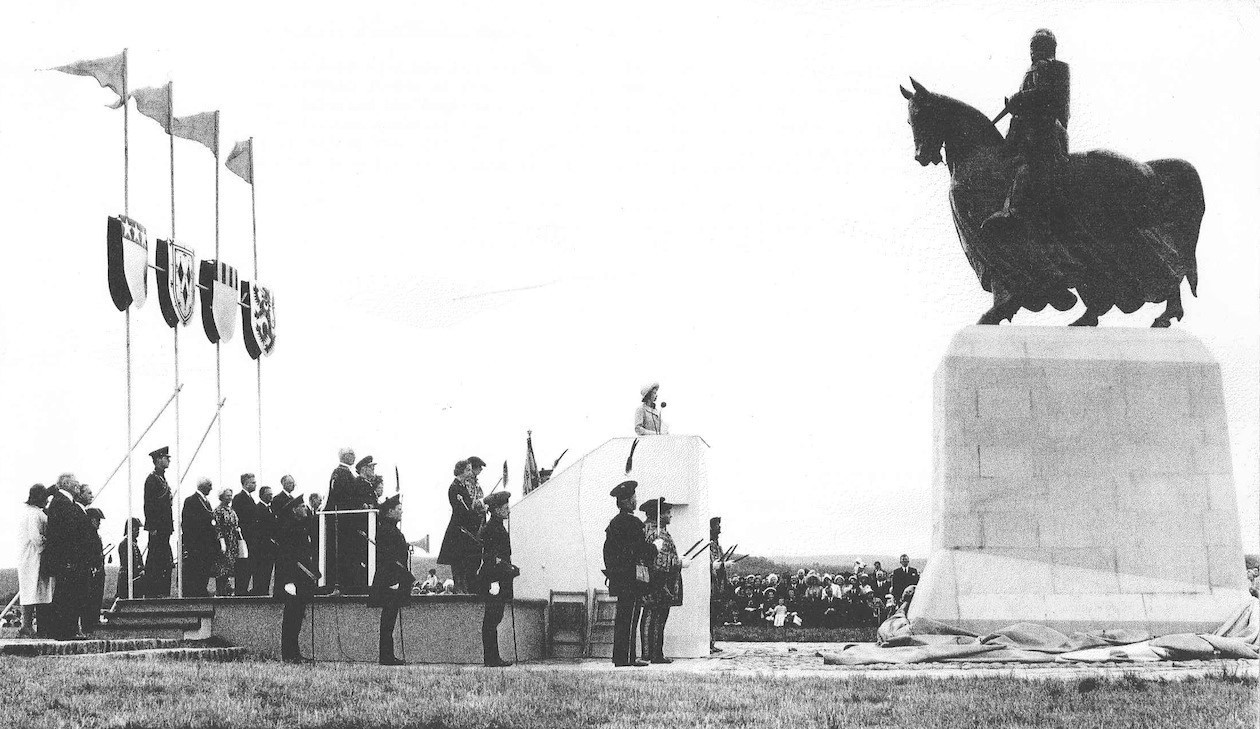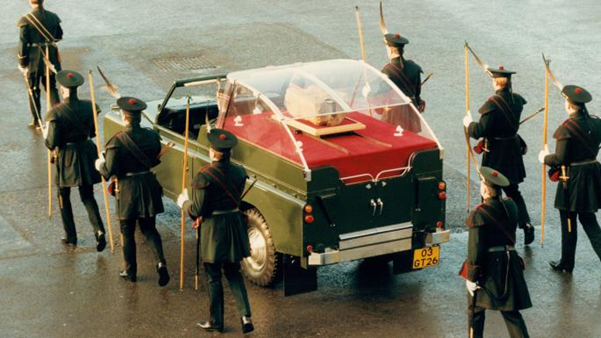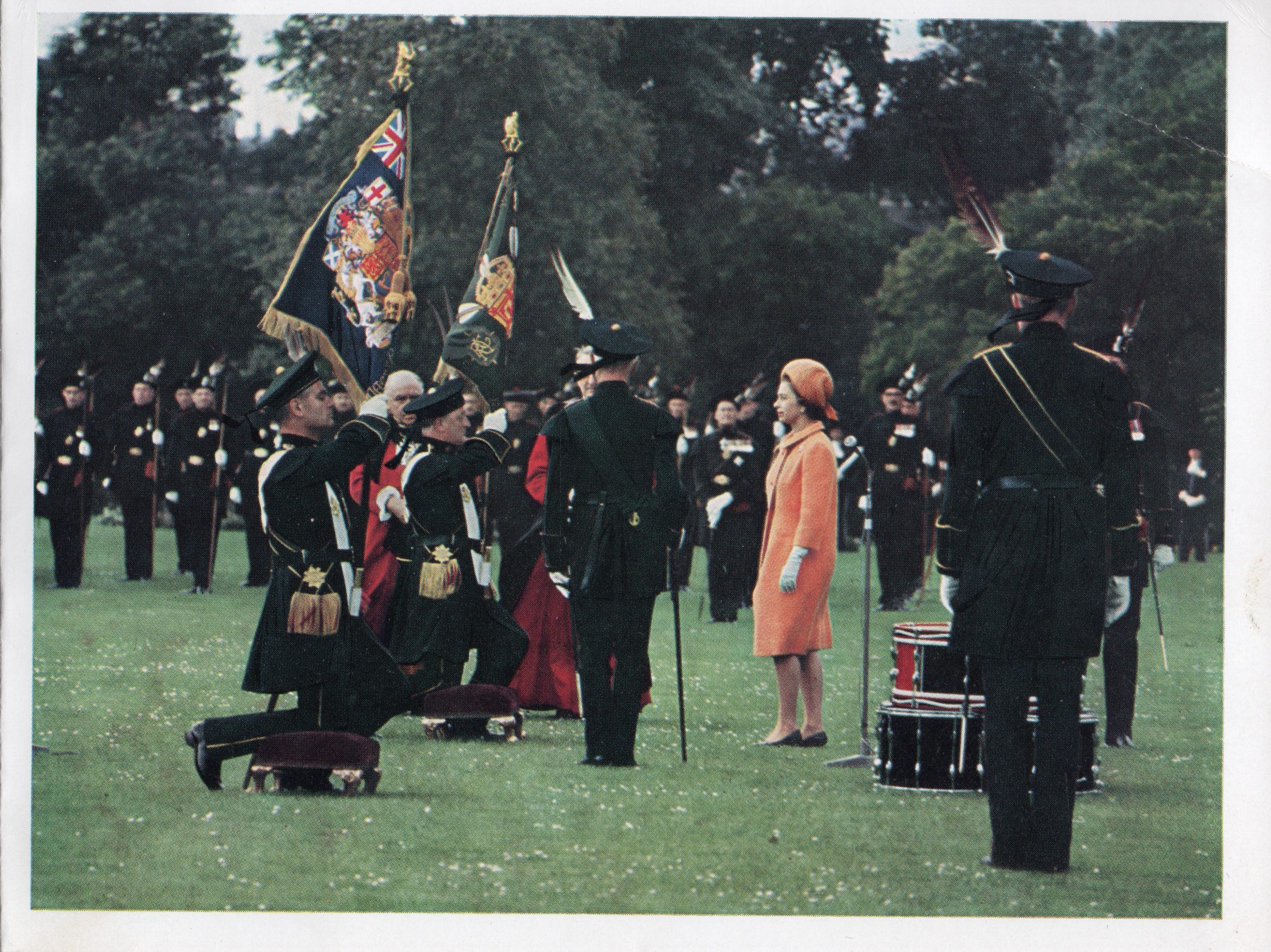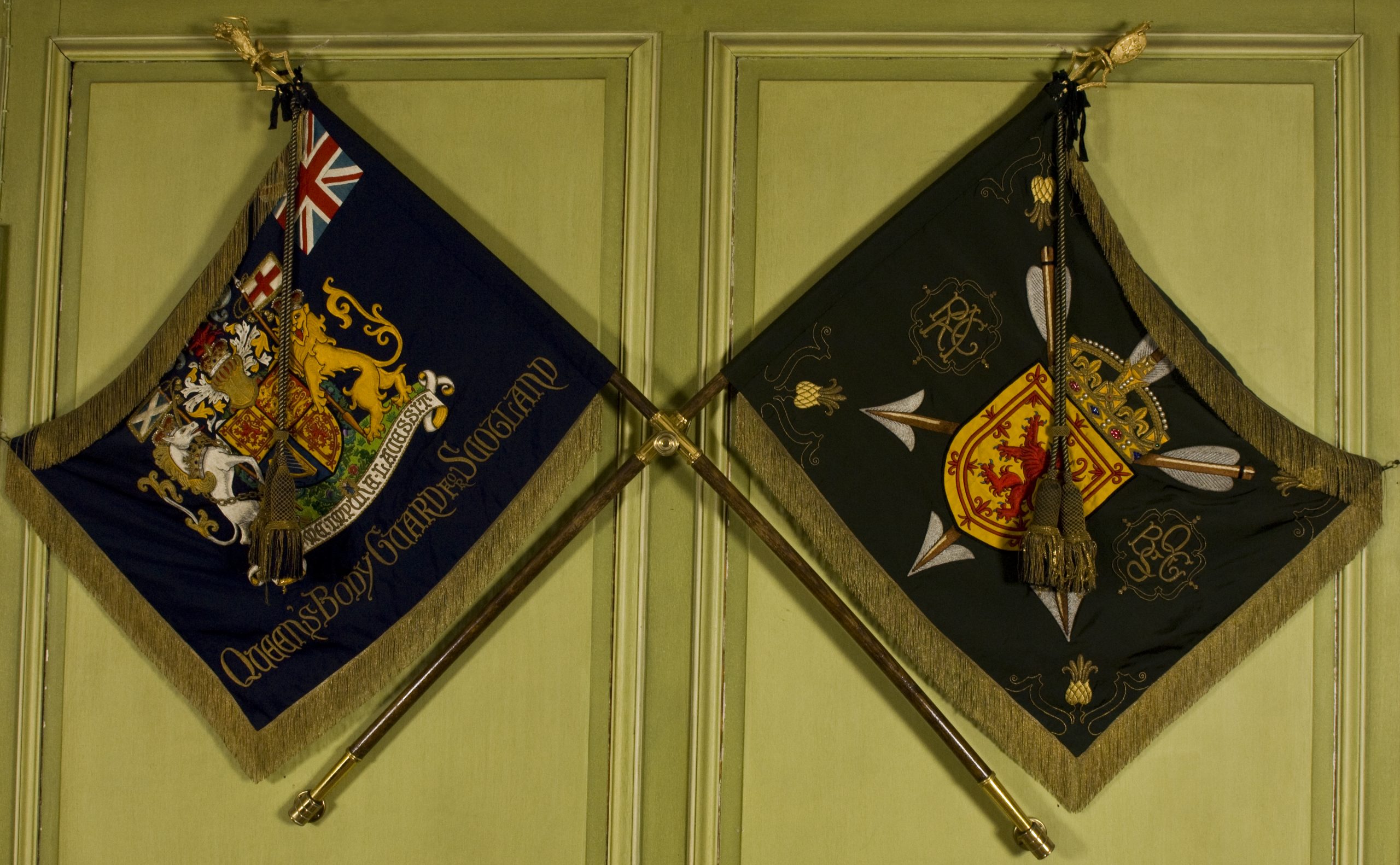The Royal Company has had the honour to serve as the Body Guard to Her Majesty The Queen in Scotland almost every year since her Accession in February 1952.
Old Acquaintance, Not Forgot
As Princess Elizabeth of York, The Queen first became acquainted with the Royal Company during the first State Visit to Scotland of her father, King George VI, in July 1937. This State Visit followed custom and included the King’s inspection of the Royal Company at the Palace of Holyroodhouse, during which the traditional Reddendo was presented, a levée, the Installation Ceremony of Her Majesty Queen Elizabeth as a member of the Order of the Thistle at St Giles’ Cathedral and the Garden Party in the grounds of Holyroodhouse. It had rained very heavily on the day of the Garden Party but ‘the Princesses [Princess Elizabeth and Princess Margaret Rose] appeared to enjoy thoroughly being helped round and over the puddles by a self-appointed posse of Royal Archers.’
The exigencies of the Munich Crisis of 1938 and then the Second World War precluded any formal Royal Visit by King George VI to Scotland until June 1948. However, having been granted permission in 1946 to shoot in the grounds of Holyroodhouse, the Royal Company were invited to demonstrate clout-shooting at ‘nine-score yards.’ On 3 July 1946, a detachment of seven Archers duly demonstrated their expertise before Their Majesties the King and Queen, Princess Elizabeth and Princess Margaret Rose. Such was the success of this demonstration that the Royal Company presented the King with two yew bows. Two Archers were subsequently invited to Balmoral to provide instruction and there, on 23 August 1946, Princess Elizabeth scored a ‘gold’ with her first arrow.
The first post-War Royal Visit to Scotland was in the summer of 1948. Princess Elizabeth, recently married to Prince Philip, The Duke of Edinburgh, and expecting their first child, did not attend. The visit, which followed the customary programme, was ‘an outstanding success in every way.’
The Accession and Coronation, 1952 and 1953
The Queen succeeded her father in February 1952. A detachment of the Royal Company paraded on 8 February 1952 at Edinburgh’s Mercat Cross when the Lord Lyon read the Proclamation of Accession of Her Majesty Queen Elizabeth II. Queen Elizabeth paid her first Royal Visit to Scotland in June 1952.
Following the Queen’s Inspection of 242 officers and Archers of The Queen’s Body Guard for Scotland, Royal Company of Archers, at Holyroodhouse on 26 June 1952, she was presented with the Reddendo in the form of a diamond, ruby and emerald brooch which includes the traditional ‘pair’ of arrows in white gold. That same evening, the Queen dined with the Royal Company at Archers’ Hall. History records that the Queen’s ‘interest in the Royal Company, its history, its traditions and its problems, was manifest.’
Ten Archers took part at the Coronation on 2 June 1953. The Captain-General, the 12th Earl of Stair, took his place in the Procession as Gold Stick for Scotland immediately after his English counterpart. This was the first time that The Royal Company had undertaken an official role at a Coronation.
National Service of Thanksgiving, 24 June 1953
Shortly after her Coronation, Queen Elizabeth paid a State Visit to Scotland during which The Royal Company played a full part. The most memorable event was the magnificent National Service of Thanksgiving at St Giles on 24 June 1953 for which the Royal Company provided both an Outside and an Inside Guard at the Cathedral. The Queen’s carriage was escorted through the streets of Edinburgh by a marching party of Archers.
The Crown and Sceptre of Scotland, escorted by ten Archers, were borne in procession from Edinburgh Castle to St Giles’s Cathedral for the Service. The Crown and the Sceptre date from reigns of James IV and James V in the late 15th and early 16th centuries. The Honours of Scotland had last been presented to the Sovereign 131 years before to King George IV in the Throne Room at the Palace of Holyroodhouse on 15 August 1822.
It would be another 46 years before the Honours of Scotland left the Castle again, with an escort of Archers, for the Opening of the Scottish Parliament on 1 July 1999. The Royal Company continues to provide an Escort to The Honours as was seen on 5th July 2023.
Body Guard Duties since 1953
‘Royal Week’ (or ‘Holyrood Week’), normally from the end of June to the beginning of July, has become a familiar annual feature of the Scottish fabric. Taking up residence at the Palace of Holyroodhouse, The Sovereign meets Scots from all walks of life at a wide range of locations as well as at the Garden Party. The Royal Company serves throughout the week as The King’s Body Guard at the Palace and at St Giles’ Cathedral for services for the installation of The Knights of the Most Ancient and Most Noble Order of the Thistle.
The Royal Company has also been on duty for other, less usual, events throughout Queen Elizabeth’s reign. The Royal Company provided a Guard when She unveiled the statue of King Robert the Bruce at Bannockburn on 24 June 1964, the 650th anniversary of the battle. Later that year, on 4 September, the Royal Company again provided a detachment of Archers when Queen Elizabeth opened the Forth Road Bridge.
The Presentation of New Colours, 28 June 1966
22 Officers and 253 Archers paraded for the presentation of new Colours by Queen Elizabeth II on 28 June 1966, the largest assembly of The Royal Company to that date. The old Colours had been presented by King George V in 1911 and, like their predecessors, had seen service in four reigns. Two days of rehearsals resulted in a magnificent ceremony in the gardens of Holyroodhouse. The Royal Company was privileged by the following gracious address by Queen Elizabeth II:
‘It has been a great pleasure for me to be able to inspect so many of you this morning.
During my reign you have provided guards for great occasions in Scotland, and you have already given most valuable service at the Garden Parties here at the Palace of Holyroodhouse. But is not often that Edinburgh has the chance to see the Royal Company paraded as a whole.
Indeed, the last time this happened in 1952 when you gave me the traditional Reddendo disguised as the very beautiful brooch which I am wearing today.
On this occasion, I have been very pleased to give you your new Colours to replace those presented by King George V in 1911. They are a mark of the close relationship that exists between us and of the value I place in the services of my Body Guard for Scotland.’
The Captain-General, the Duke of Buccleuch, concluded his reply to Queen Elizabeth:
‘Your Majesty has no more loyal and faithful subjects in your Dominions than the Royal Company of Archers, who are proud to bear these Colours and proud also of the great privilege we enjoy to serve Your Majesty as your Body Guard for Scotland.’
The Royal Company were honoured by the presence of Queen Elizabeth II, accompanied by Prince Philip, at a ball in the Assembly Rooms that evening.
The General Assembly of the Church of Scotland, 20 May 1969
The Sovereign has sworn to maintain the Church of Scotland since the 16th century, a duty affirmed in the 1707 Act of Union between England and Scotland. The General Assembly meets annually to hear reports from the councils and committees, make laws and set the agenda for the national Church. The Sovereign is usually represented by the Lord High Commissioner who attends as an observer and takes up residence at the Palace of Holyroodhouse for the week that the Assembly meets. They are appointed by The Sovereign on the advice of the Prime Minister. Queen Elizabeth has attended the General Assembly in person twice during her reign: in 1969 and 2002. This had not happened for over 350 years.
The Captain-General, the Duke of Buccleuch, was appointed in 2018 and 2019 to undertake this role. The Royal Company took part for the first time in the arrival ceremony on 17 May 2019 at the Palace of Holyroodhouse along with the Guard of Honour formed by The Royal Scots Dragoon Guards. The following day, a detachment of 2 officers and 12 Archers took part in the arrival ceremony of the Lord High Commissioner for the Opening of the General Assembly at New College, Edinburgh. It has been agreed that The Royal Company will take part in both ceremonies in future years.
The Tercentenary Parade and Ball, 19 October 1976
Queen Elizabeth II paid her Body Guard the great honour of coming from Balmoral to Edinburgh for the Tercentenary of the Royal Company on 19 October 1976. The Tercentenary celebrations consisted of an Inspection Parade in the grounds of Holyroodhouse of which the centrepiece was the presentation to Her Majesty, for the second time, of a Reddendo, followed by the Tercentenary Ball the same evening. 21 Officers and 290 Archers were on parade, a record number for the Royal Company at the time. paraded at Holyroodhouse on 19 October 1976 to mark the Tercentenary of the foundation. The Reddendo, in the form of a crystal goblet with the three barbed arrows on the lid and the goblet itself bearing an engraving of Archers shooting in the Garden of Holyroodhouse, was presented by the Captain-General, the Earl of Stair. The Queen was graciously pleased to address the Royal Company:
‘Today marks the three hundredth anniversary of your foundation and I warmly congratulate you on an important milestone in your history. May the Royal Company flourish for centuries yet to come!
I wish also to thank you all for your loyalty and for the splendid service you give to this Palace and on great occasions throughout Scotland. I value this very much.’

